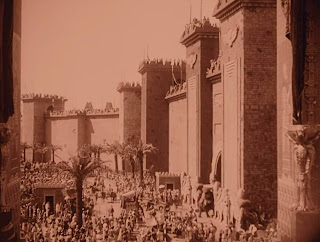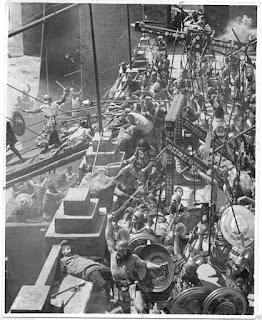Intolerance: Love's Struggle Throughout the Ages (1916)
Director: D.W. Griffith Writers: D.W. Griffith (scenario) Anita Loos (titles) During filming of the battle sequences, many of the extras got so into their characters that they caused real injury to each other. At the end of one shooting day, a total of 60 injuries were treated at the production's hospital tent. The Babylonian orgy sequence alone cost $200,000 when it was shot. That's nearly twice the overall budget of The Birth of a Nation (1915), another D.W. Griffith film and, at the time, the record holder for most expensive picture ever made. D.W. Griffith invested more than $2 million in this film, an unprecedented amount of money at the time. Unfortunately, it never even came close to earning back its budget--audiences in 1916 were completely unused to seeing films that ran in excess of three hours. Even when it was re-cut and released as two separate features, "The Fall of Babylon" and "The Mother and the Law", it still failed to make money. The massive life-size set of the Great Wall of Babylon, seen in the fourth story, was placed at the corner of Sunset Boulevard and Hollywood Boulevard (in Hollywood, California) when the movie was completed. It became a notable landmark for many years during Hollywood's golden era. It actually stood on the lot of the studio on Prospect Avenue near the Sunset & Hollywood Boulevard junctions in the eastern end of the city. It was the first such exterior set ever built in Hollywood. Falling into disrepair, it was eventually torn down. Years later, this same Babylon set was replicated as the central courtyard design for the new Hollywood & Highland complex in Hollywood, which opened in 2001. Included among the "1001 Movies You Must See Before You Die", edited by Steven Schneider.
The abandoned set from “Intolerance” rots away in Los Angeles …
The Intolerance set came to resemble an architectural model on a huge scale, albeit not a particularly accurate one. It’s sheer scale was overwhelming- massive, truly expansive, a monument in its own right, except it honored Griffith and the cinema instead of the Kings of Babylon- similar structures built more than a thousand years apart for entirely different purposes. The set strove for a ‘heightened’ realism- it was aggressive in its authenticity, but was still altered and changed from the ‘true’, architectural building it aped to make it appear more realistic through the camera’s moderated eye. The set of Intolerance was an imperfect doppelganger, an artificial archeology that reflected the grand idea of Babylon more than its more practical reality.
Despite the set of Intolerance being, by its very nature, fake, it actually became an actual archeological ruin of a certain nature, for at least a short while. The huge costs of the film made disassembling the set impossible, since labor costs had already been overrun so heavily and Hollywood studios are, if anything, hesitant to sink more money into a film that has already been released. The film’s box office was also somewhat less than expected, although the film eventually did turn a profit- audiences weren’t very taken with the complicated four-part plot, preferring to spend their money on tamer fare that was less preachy. As a result, the set lay abandoned since the producers refused to spend more money to destroy their fake city. Thus, for a time, Los Angeles had an abandoned Babylon within its borders, quickly deteriorating in the wind and weather as the cheap production processes set design use as their trademark slowly came undone. It soon became something of a tourist attraction, despite its worsening condition, and the city’s frequent fines.
An abstract question presents itself- had some disaster befallen the Earth in the winter of 1916, destroying our civilization in some sort of surreal, divine punishment for the forthcoming sins of flappers and Art Deco, would future archaeologists, coming across a ruined Babylon in sunny Los Angeles, have believed Hammurabi’s code had been proclaimed on the corner of Santa Monica Boulevard instead from ancient Iran? Eventually, the set for Intolerance burned down in the 1920s, either as an accident or through the actions of producers still hesitant to spend money on removing the huge structure.
Photograph:
(The abandoned set from Intolerance rots away in Los Angeles after the film has finished shooting, but before a fire destroyed the structure)
Hanson, Bernard. ‘D.W. Griffith: Some Sources.’ The Art Bulletin, Vol. 54, No. 4, 1972.
The abandoned set from “Intolerance” rots away in Los Angeles …
The Intolerance set came to resemble an architectural model on a huge scale, albeit not a particularly accurate one. It’s sheer scale was overwhelming- massive, truly expansive, a monument in its own right, except it honored Griffith and the cinema instead of the Kings of Babylon- similar structures built more than a thousand years apart for entirely different purposes. The set strove for a ‘heightened’ realism- it was aggressive in its authenticity, but was still altered and changed from the ‘true’, architectural building it aped to make it appear more realistic through the camera’s moderated eye. The set of Intolerance was an imperfect doppelganger, an artificial archeology that reflected the grand idea of Babylon more than its more practical reality.
Despite the set of Intolerance being, by its very nature, fake, it actually became an actual archeological ruin of a certain nature, for at least a short while. The huge costs of the film made disassembling the set impossible, since labor costs had already been overrun so heavily and Hollywood studios are, if anything, hesitant to sink more money into a film that has already been released. The film’s box office was also somewhat less than expected, although the film eventually did turn a profit- audiences weren’t very taken with the complicated four-part plot, preferring to spend their money on tamer fare that was less preachy. As a result, the set lay abandoned since the producers refused to spend more money to destroy their fake city. Thus, for a time, Los Angeles had an abandoned Babylon within its borders, quickly deteriorating in the wind and weather as the cheap production processes set design use as their trademark slowly came undone. It soon became something of a tourist attraction, despite its worsening condition, and the city’s frequent fines.
An abstract question presents itself- had some disaster befallen the Earth in the winter of 1916, destroying our civilization in some sort of surreal, divine punishment for the forthcoming sins of flappers and Art Deco, would future archaeologists, coming across a ruined Babylon in sunny Los Angeles, have believed Hammurabi’s code had been proclaimed on the corner of Santa Monica Boulevard instead from ancient Iran? Eventually, the set for Intolerance burned down in the 1920s, either as an accident or through the actions of producers still hesitant to spend money on removing the huge structure.
Photograph:
(The abandoned set from Intolerance rots away in Los Angeles after the film has finished shooting, but before a fire destroyed the structure)
Hanson, Bernard. ‘D.W. Griffith: Some Sources.’ The Art Bulletin, Vol. 54, No. 4, 1972.

























































Comments
Post a Comment